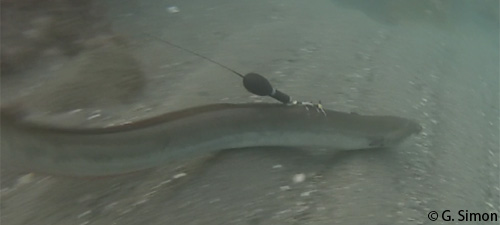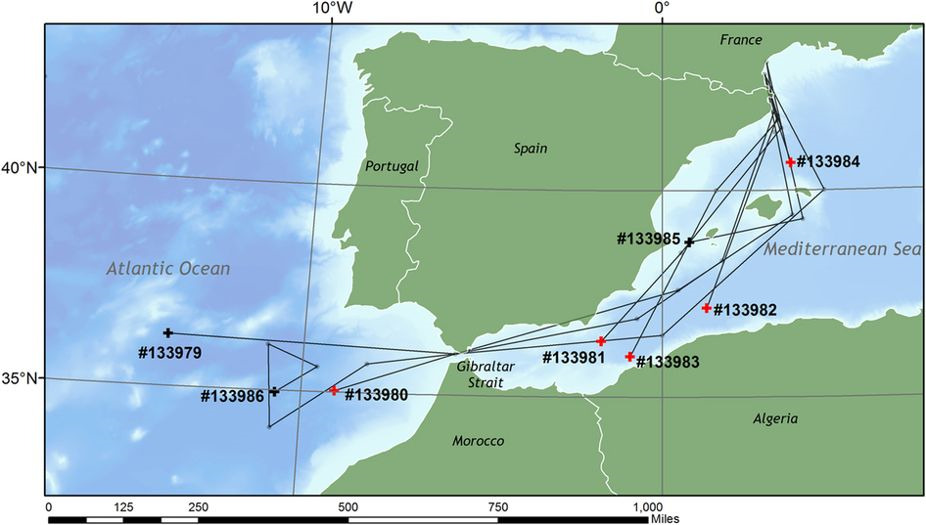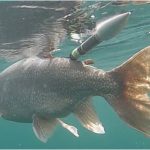← Back
Eels’ travel in the Atlantic tracked by Argos satellite telemetry

Eels, threatened by pollution, virus and parasites, overfishing, habitat loss and climate change have seen their population drop in the past decades. Their life and behaviour are studied to better understand the causes of this decrease. Their migration – when adults cross the Atlantic to the Sargasso Sea to reproduce and die- is of particular interest to scientists. This voyage is still not fully understood, but Argos satellite telemetry is helping to shed light on the first part of this process, as Elsa Amilhat of the University of Perpignan reveals.
The population of European eels (Anguilla anguilla) has dropped dramatically since the 1980s, without one single reason clearly pinpointed, but a number of possibilities.
Tracking silver eels with Argos
To gain more information about the species, 23 silver eels (future spawner life stage) leaving the Mediterranean coasts to reproduce in the Sargasso Sea have been tagged since 2013 by an international team composed of scientists from the CEFREM laboratory at University of Perpignan, France (Elsa Amilhat, Gaël Simon and Elisabeth Faliex), the DTU in Denmark (Kim Aarestrup), the CEFAS in UK (David Righton) and the SLU in Sweden (Hakan Westerberg). This project was funded by the French Ministry of Agriculture and Food and was made possible thanks to cooperation of professional fishermen in the Occitanie Region, who caught the required large eels (>1.5 kg) for tagging. We mentionned the first days of their trip, Inside the Mediterannean Sea in Eels’ travel in the Mediterranean tracked thanks to Argos & goniometer.
The use of Argos pop-up tags for satellite tracking brought a lot of interesting information, like their characteristic diel vertical migration: they go up to 200-400 m depth at night and down to 600-800 m during the day. The path, speed and duration of their long migration from Europe to Sargasso was also recorded with some surprises, like the unexpected length of time they take to leave the Mediterranean, the mean speed (the fastest swim at 16.5 km/day, the slowest at 4 km/day).
From the Mediterranean to the Atlantic
Four tags popped-up at the programmed date (6 – 8 months) in the Atlantic. This demonstrates for the first time that eels from the Mediterranean Sea are able to cross Gibraltar Strait and contribute to the spawning stock in the Atlantic. One of these eels, released at Gibraltar, was tracked up to the Azores, the closest location from the Sargasso Sea known up to now from all the tagging experiments done on the European eel (from Atlantic and Mediterranean Sea tagging experiments done on the European eel). The trip to the Sargasso is not easy. To complete the 6,000 km separating them from the Sargasso Sea the eels must rely on their fat stock, not eating at all. They also have to avoid predation, as a high predation rate, at least 40%, mostly by marine mammals was observed in these studies.
Some questions nevertheless remain unanswered: what is the route they use to reach the Sargasso Sea, and how long does it take ?

Satellite Tracks of the 8 eels tagged in 2013 from the lagoons near Perpignan and out of the Mediterranean in their migration (tracks lasting between 26 and 177 days; pop-up were programmed to detach after 6 months). Their trajectories cannot be determined from daylight measurements since they swim at depth where light does not penetrate. Indirect methods were used to reconstruct the trajectories. Crosses mark the pop-up position of each tag. Black crosses denote the tags that surfaced at the programmed date, while red crosses indicate the pop-up positions of tags attached to eels taken by predators. The map was drawn in Esri ArcMap 10.1, using GEBCO bathymetry (http://www.gebco.net/) and ESRI map (http://www.esri.com/software/arcgis) data. (Credits CEFAS) Results of this study have been published in Nature Scientific Report [Amilhat et al., 2016] .
Photo: An eel in the sea with a pop-up tag. Credits G. Simon, Perpignan University
References
Elsa Amilhat, Kim Aarestrup, Elisabeth Faliex, Gaël Simon, Håkan Westerberg, David Righton, 2016: First evidence of European eels exiting the Mediterranean Sea during their spawning migration, Nature Scientific Reports, DOI: 10.1038/srep21817 7
http://www.nature.com/srep/2016/160224/srep21817/full/srep21817.html
Useful links
CEFREM : Elsa Amilhat elsa.amilhat@univ-perp.fr/ Gael Simon gsimon@univ-perp.fr/Elisabeth Faliex faliex@univ-perp.fr
DTU : Kim Aarestrup kaa@aqua.dtu.dk
CEFAS: David Righton (Cefas) <david.righton@cefas.co.uk>
SLU : Håkan Westerberg <hakan.westerberg@slu.se>

